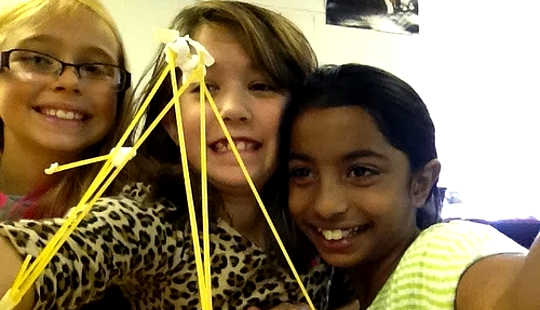
Kids ages 7 to 12 rate gender as more important to their social identities than race, say researchers. The research also suggests children of color think about race differently than their white peers do.
“Kids are thinking about race and gender, and not just in terms of being able to identify with these social categories, but also what they mean and why they matter,” says lead author Leoandra Onnie Rogers, a former postdoctoral fellow at the University of Washington’s Institute for Learning & Brain Sciences (I-LABS) who is now an assistant professor of psychology at Northwestern University.
Andrew Meltzoff, co-director of I-LABS and coauthor of the paper, says, “Children are bombarded by messages about race, gender, and social stereotypes. These implicit and explicit messages rapidly influence their self-concepts and aspirations.
“We were able to catch a glimpse of how culture influences children at a tender time in their lives. Kids talk about race and gender in different ways as early as age 7.”
Ranking ‘me’ cards
Published online in the journal Cultural Diversity & Ethnic Minority Psychology, the research involved interviews with 222 children in grades two through six at three racially diverse public schools in Tacoma, Washington. None of the schools had more than 50 percent of one racial group, and more than 75 percent of students were eligible for free or reduced-price lunch.
The children were first shown cards with different identity labels—boy, girl, son, daughter, student, Asian, Hispanic, black, white, and athlete—and asked to place each card in a “me” pile if the card described them or in a “not me” pile if it did not.
Children were then asked to rank the “me” cards by importance, and then to separately rate how important racial and gender identities were to them on a three-point scale—either “not much,” “a little bit,” or “a lot.” The rankings took place separately so children could rate race and gender as equally important.
The children were then asked two open-ended questions—”what does it mean to be a (boy/girl)”? and “what does it mean to be (black/white/mixed)”? All 222 responses to each question were then sorted into five broad categories that reflect the wider meaning behind these responses, including physical appearance, inequality and group difference, equality or sameness, family, and pride and positive traits. The codes were not mutually exclusive, so a single response might reference multiple topics.
The responses, which Rogers collected over the course of a year spent in the schools, found that:
- Of the five social identities represented in the “me/not me” test (gender, race, family, student, and athlete), family—being a son or daughter—was on average the most important to children
- Being a student was ranked second, followed by gender, then athlete
- Race was most consistently selected last, as the least important identity
- Black and mixed-race children ranked race as more important than white children
In response to the open-ended questions, black and mixed-race children mentioned racial pride much more often than white children did - Family identity was more important to girls than boys
- Boys ranked being an athlete higher than girls did, and black boys ranked it significantly higher than did all other children
- The meanings children ascribed to gender identity tended to emphasize inequality and group differences, while meanings of race emphasized physical appearance and equality
- There was no difference between boys and girls about how important gender was, but girls mentioned physical appearance as part of their gender identity much more often than boys
- Girls made up 77 percent of the references to physical appearance when defining what gender means (for example, “I think [being a girl] means glam. Like looking glamorous and pretty for everyone.”)
“Most white kids would say [race] is not important, it doesn’t matter, but kids of color would say, ‘Yes, race does matter to me.'”
About half of black and mixed-race children ranked race as “a lot” or a “little” important, while 89 percent of white children considered race a “not important” part of their identity. That gap is telling, Rogers says, particularly given that the schools involved are highly diverse.
“In some ways, it suggests that white kids and kids of color are navigating very different worlds when it comes to race and they’re thinking about race in very different terms,” says Rogers. “Most white kids would say [race] is not important, it doesn’t matter, but kids of color would say, ‘Yes, race does matter to me.'”
In the open-ended question about racial identity, 42 percent of responses that defined the meaning of race through values of equality or humanism came from white children (for example, “I believe race doesn’t matter at all. It just matters about who you are.”). By contrast, just one-quarter of black and mixed-race children mentioned equality when talking about race.
Race as a ‘taboo topic’
While the emphasis on equity among white children may seem encouraging, Rogers says some white children interviewed were reluctant to broach the subject of race. When asked what it meant to be white, she recalled, one white third-grader refused to talk about it.
“The idea that talking about race is taboo was prevalent,” she says. “Surprisingly, that is not uncommon in diverse schools. The narrative of multiculturalism is really stressed in such a way that everybody’s the same and differences are minimized.”
“That typically derives from the good motivation of encouraging kids to treat each other respect and not allowing discrimination to occur,” Rogers says. “But it might also communicate racial silence, that race is something that’s not OK to talk about.”
By contrast, she says, it makes sense that children view gender as more important than race, since gender differences are openly discussed, accepted, and celebrated in the broader society, for better or worse.
“Kids are sorted by girls and boys all the time,” she says. “It would be egregious to do such a thing based on race today. There is a way we premeditate gender divisions and accept them as fact. Some kids push back on that, but it means there is a space to talk about it, that it’s not a taboo conversation.”
How to talk about race with kids
The research dovetails with two online training modules developed by Rogers and the I-LABS team focused on how children learn about race and how parents and teachers can talk with them about race in a helpful way. The modules are free and come with discussion guides intended to facilitate personal reflections and group conversations.
“As parents, we teach values through the conversations we have with our children,” Meltzoff says. “We’re hoping that these modules can help enrich parent-child talk about socially sensitive issues.”
Overall, Rogers says, the study reinforces the need to better understand how multiple factors, from school culture to societal stereotypes, influence the formation of children’s social identities.
“The issue is not that we’re different. It’s in the hierarchy and the value that’s placed on those differences,” Rogers says. “We really need more data and understanding of which messages promote social justice and equity, and which promote blindness, avoidance, and silence.”
About the Authors
The National Science Foundation and the Spencer Foundation/National Academy of Education funded the work.
Source: University of Washington
Related Books
at InnerSelf Market and Amazon



























